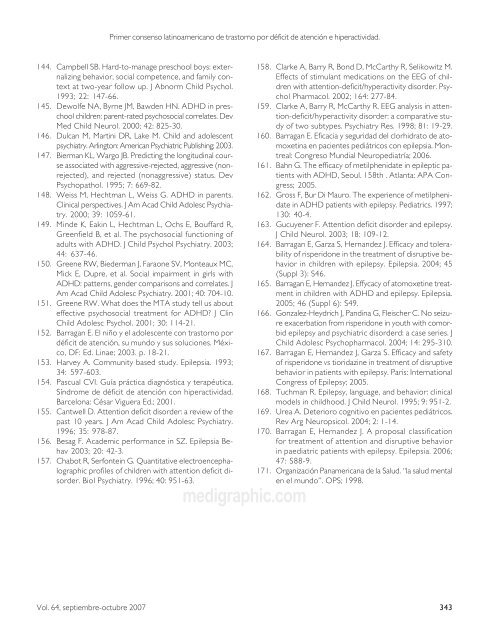Primer consenso latinoamericano de trastorno por déficit de - TDAH ...
Primer consenso latinoamericano de trastorno por déficit de - TDAH ...
Primer consenso latinoamericano de trastorno por déficit de - TDAH ...
Create successful ePaper yourself
Turn your PDF publications into a flip-book with our unique Google optimized e-Paper software.
Vol. 64, septiembre-octubre 2007<br />
<strong>Primer</strong> <strong>consenso</strong> <strong>latinoamericano</strong> <strong>de</strong> <strong>trastorno</strong> <strong>por</strong> <strong>déficit</strong> <strong>de</strong> atención e hiperactividad.<br />
144. Campbell SB. Hard-to-manage preschool boys: externalizing<br />
behavior, social competence, and family context<br />
at two-year follow up. J Abnorm Child Psychol.<br />
1993; 22: 147-66.<br />
145. Dewolfe NA, Byrne JM, Baw<strong>de</strong>n HN. ADHD in preschool<br />
children: parent-rated psychosocial correlates. Dev<br />
Med Child Neurol. 2000; 42: 825-30.<br />
146. Dulcan M, Martini DR, Lake M. Child and adolescent<br />
psychiatry. Arlington: American Psychiatric Publishing; 2003.<br />
147. Bierman KL, Wargo JB. Predicting the longitudinal course<br />
associated with aggressive-rejected, aggressive (nonrejected),<br />
and rejected (nonaggressive) status. Dev<br />
Psychopathol. 1995; 7: 669-82.<br />
148. Weiss M, Hechtman L, Weiss G. ADHD in parents.<br />
Clinical perspectives. J Am Acad Child Adolesc Psychiatry.<br />
2000; 39: 1059-61.<br />
149. Min<strong>de</strong> K, Eakin L, Hechtman L, Ochs E, Bouffard R,<br />
Greenfield B, et al. The psychosocial functioning of<br />
adults with ADHD. J Child Psychol Psychiatry. 2003;<br />
44: 637-46.<br />
150. Greene RW, Bie<strong>de</strong>rman J, Faraone SV, Monteaux MC,<br />
Mick E, Dupre, et al. Social impairment in girls with<br />
ADHD: patterns, gen<strong>de</strong>r comparisons and correlates. J<br />
Am Acad Child Adolesc Psychiatry. 2001; 40: 704-10.<br />
151. Greene RW. What does the MTA study tell us about<br />
effective psychosocial treatment for ADHD? J Clin<br />
Child Adolesc Psychol. 2001; 30: 114-21.<br />
152. Barragan E. El niño y el adolescente con <strong>trastorno</strong> <strong>por</strong><br />
<strong>déficit</strong> <strong>de</strong> atención, su mundo y sus soluciones. México,<br />
DF: Ed. Linae; 2003. p. 18-21.<br />
153. Harvey A. Community based study. Epilepsia. 1993;<br />
34: 597-603.<br />
154. Pascual CVI. Guía práctica diagnóstica y terapéutica.<br />
Síndrome <strong>de</strong> <strong>déficit</strong> <strong>de</strong> atención con hiperactividad.<br />
Barcelona: César Viguera Ed.; 2001.<br />
155. Cantwell D. Attention <strong>de</strong>ficit disor<strong>de</strong>r: a review of the<br />
past 10 years. J Am Acad Child Adolesc Psychiatry.<br />
1996; 35: 978-87.<br />
156. Besag F. Aca<strong>de</strong>mic performance in SZ. Epilepsia Behav<br />
2003; 20: 42-3.<br />
157. Chabot R, Serfontein G. Quantitative electroencephalographic<br />
profiles of children with attention <strong>de</strong>ficit disor<strong>de</strong>r.<br />
Biol Psychiatry. 1996; 40: 951-63.<br />
medigraphic.com<br />
158. Clarke A, Barry R, Bond D, McCarthy R, Selikowitz M.<br />
Effects of stimulant medications on the EEG of children<br />
with attention-<strong>de</strong>ficit/hyperactivity disor<strong>de</strong>r. Psychol<br />
Pharmacol. 2002; 164: 277-84.<br />
159. Clarke A, Barry R, McCarthy R. EEG analysis in attention-<strong>de</strong>ficit/hyperactivity<br />
disor<strong>de</strong>r: a comparative study<br />
of two subtypes. Psychiatry Res. 1998; 81: 19-29.<br />
160. Barragan E. Eficacia y seguridad <strong>de</strong>l clorhidrato <strong>de</strong> atomoxetina<br />
en pacientes pediátricos con epilepsia. Montreal:<br />
Congreso Mundial Neuropediatría; 2006.<br />
161. Bahn G. The efficacy of metilphenidate in epileptic patients<br />
with ADHD, Seoul. 158th . Atlanta: APA Congress;<br />
2005.<br />
162. Gross F, Bur Di Mauro. The experience of metilphenidate<br />
in ADHD patients with epilepsy. Pediatrics. 1997;<br />
130: 40-4.<br />
163. Gucuyener F. Attention <strong>de</strong>ficit disor<strong>de</strong>r and epilepsy.<br />
J Child Neurol. 2003; 18: 109-12.<br />
164. Barragan E, Garza S, Hernan<strong>de</strong>z J. Efficacy and tolerability<br />
of risperidone in the treatment of disruptive behavior<br />
in children with epilepsy. Epilepsia. 2004; 45<br />
(Suppl 3): S46.<br />
165. Barragan E, Hernan<strong>de</strong>z J. Effycacy of atomoxetine treatment<br />
in children with ADHD and epilepsy. Epilepsia.<br />
2005; 46 (Suppl 6): S49.<br />
166. Gonzalez-Heydrich J, Pandina G, Fleischer C. No seizure<br />
exacerbation from risperidone in youth with comorbid<br />
epilepsy and psychiatric disor<strong>de</strong>rd: a case series. J<br />
Child Adolesc Psychopharmacol. 2004; 14: 295-310.<br />
167. Barragan E, Hernan<strong>de</strong>z J, Garza S. Efficacy and safety<br />
of risperidone vs tioridazine in treatment of disruptive<br />
behavior in patients with epilepsy. Paris: International<br />
Congress of Epilepsy; 2005.<br />
168. Tuchman R. Epilepsy, language, and behavior: clinical<br />
mo<strong>de</strong>ls in childhood. J Child Neurol. 1995; 9: 951-2.<br />
169. Urea A. Deterioro cognitivo en pacientes pediátricos.<br />
Rev Arg Neuropsicol. 2004; 2: 1-14.<br />
170. Barragan E, Hernan<strong>de</strong>z J. A proposal classification<br />
for treatment of attention and disruptive behavior<br />
in paediatric patients with epilepsy. Epilepsia. 2006;<br />
47: S88-9.<br />
171. Organización Panamericana <strong>de</strong> la Salud. “la salud mental<br />
en el mundo”. OPS; 1998.<br />
343


